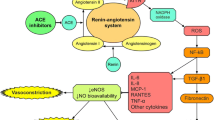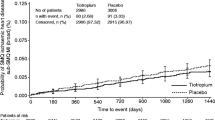Abstract
Purpose
To compare the safety of regadenoson, a selective agonist of A2A adenosine receptors, combined with low-level exercise, between subjects with mild/moderate chronic obstructive pulmonary disease (COPD) and asthma referred for myocardial perfusion imaging (MPI).
Methods
We studied 116 patients, of whom 67 had COPD and 49 asthma (62 % men, mean age 68.3 ± 11.3 years, range 31 – 87 years). Patient demographics, past medical history, medications, clinical symptoms during stress and changes in blood pressure (BP) and heart rate (HR) were evaluated.
Results
Both groups were comparable with regard to hypertension, dyslipidaemia, diabetes and medications with the exception of a higher rate of use of anticholinergics in patients with COPD and of antileukotrienes in asthmatics (58.2 % vs. 28.6 % and 1.5 % vs. 14.3 %, respectively; all p < 0.01). There was a higher incidence of dyspnoea in COPD patients and of headache and feeling hot in asthmatic patients (40.3 % vs. 22.4 %, 6 % vs. 18.4 % and 10.4 % vs. 26.5 %, respectively; all p < 0.05). Although there was no difference in the incidence of other adverse events, we observed a higher frequency in asthmatics of flushing, dry mouth, sweating and fatigue (1.5 % vs. 6.1 %, 14.9 % vs. 24.5 %, 0 % vs. 4.1 % and 37.3 % vs. 49 %, respectively). Adverse events were self-limiting, except in three patients who suffered persistent dyspnoea (2 of 67 COPD patients; 1 of 49 asthma patients) requiring theophylline administration. We observed no significant changes in BP among either group, but there was a tendency towards a higher increase in systolic BP in COPD patients following regadenoson administration (148.3 ± 27.6 vs. 154.6 ± 31.0 mmHg, p = 0.056).
Conclusion
This study showed a good safety profile in our series of COPD and asthma patients undergoing MPI. Regadenoson was well tolerated by all patients, with dyspnoea, headache and feeling hot showing differences between groups.



Similar content being viewed by others
References
Strauss HW, Miller DD, Wittry MD, Cerqueira MD, Garcia EV, Iskandrian AS, et al. Procedure guideline for myocardial perfusion imaging 3.3. J Nucl Med Technol. 2008;36:155–61.
McGeoch RJ, Oldroyd KG. Pharmacological options for inducing maximal hyperemia during studies of coronary physiology. Catheter Cardiovasc Interv. 2008;71:198–204.
Henzlova MJ, Cerqueira MD, Taillefer R, Mahmarian JJ, Yao SS. Quality Assurance Committee of the American Society of Nuclear Cardiology. Stress protocols and tracers. J Nucl Cardiol. 2009. doi:10.1007/s12350-009-9062-4.
Burkhart KK. Respiratory failure following adenosine administration. Am J Emerg Med. 1993;11:249–50.
Adenoscan. Package insert. 2008. Health Ministry. Spain.
Thompson RC. Regadenoson stress in patients with asthma and COPD: a breath of fresh air. J Nucl Cardiol. 2012;19(4):647–8.
European Medicines Agency. Assessment report for Rapiscan. London: European Medicines Agency; 2010. http://www.ema.europa.eu/docs/en_GB/document_library/EPAR_-_Public_assessment_report/human/001176/WC500097103.pdf. Accessed 29 Jun 2013.
Lexiscan (Regadenoson) injection [package insert]. Deerfield: Astellas Pharma US, Inc; 2011.
Cerqueira MD. Advances in pharmacologic agents in imaging: new A2A receptor agonists. Curr Cardiol Rep. 2006;8:119–22.
Leaker BR, O’Connor B, Hansel TT, Barnes PJ, Meng L, Mathur VS, et al. Safety of regadenoson, an adenosine A2A receptor agonist for myocardial perfusion imaging, in mild asthma and moderate asthma patients: a randomized, double-blind, placebo-controlled trial. J Nucl Cardiol. 2008;15:329–36.
Thomas GS, Tammelin BR, Schiffman GL, Marquez R, Rice DL, Milikien D, et al. Safety of regadenoson, a selective adenosine A2A agonist, in patients with chronic obstructive pulmonary disease: a randomized, double-blind, placebo-controlled trial (RegCOPD trial). J Nucl Cardiol. 2008;15:319–28.
Prenner BM, Bukofzer S, Behm S, Feaheny K, McNutt BE. A randomized, double-blind, placebo-controlled study assessing the safety and tolerability of regadenoson in subjects with asthma or chronic obstructive pulmonary disease. J Nucl Cardiol. 2012;19(4):681–92.
Iskandrian AE, Bateman TM, Beladinelli L, Blackburn B, Cerqueira MD, Hendel RC. Adenosine versus regadenoson comparative evaluation in myocardial perfusion imaging: results of the ADVANCE phase 3 multicenter international trial. J Nucl Cardiol. 2007;14(5):645–58.
Cerqueira MD, Nguyen P, Staehr S, Underwood R, Iskandrian AE; ADVANCE-MPI Trial Investigators. Effects of age, gender, obesity and diabetes on the efficacy and safety of the selective A2A agonist regadenoson versus adenosine in myocardial perfusion imaging: integrated ADVANCE-MPI trial results. J Am Coll Cardiol Imaging. 2008;1(3):307–16.
Walker BA, Jacobson MA, Knight DA, Salvatore CA, Weir T, Zhou D, et al. Adenosine A3 receptor expression and function in eosinophils. Am J Respir Cell Mol Biol. 1997;16(5):531–7.
Brown RA, Clarke GW, Ledbetter CL, Hurle MJ, Denyer JC, Simcock DE, et al. Elevated expression of adenosine A1 receptor in bronchial biopsy specimens from asthmatic subjects. Eur Respir J. 2008;31(2):311–9.
Bjorck T, Gustafsson LE, Dahlen SE. Isolated bronchi from asthmatics are hyperresponsive to adenosine, which apparently acts indirectly by liberation of leukotrienes and histamine. Am Rev Respir Dis. 1992;145(5):1087–91.
Thomas GS, Thompson RC, Miyamoto MI, Ip TK, Rice DL, Milikien D, et al. The RegEx trial: a randomized, double-blind, placebo- and active-controlled pilot study combining Regadenoson, a selective A2A adenosine agonist, with low-level exercise, in patients undergoing myocardial perfusion imaging. J Nucl Cardiol. 2009;16(1):63–72.
Kwon DH, Cerqueira MD, Young R, Houghtaling P, Lieber E, Menon V, et al. Lessons from regadenoson and low-level treadmill/regadenoson myocardial perfusion imaging: initial clinical experience in 1263 patients. J Nucl Cardiol. 2010;17(5):853–7.
Dhalla AK, Wong M, Wang W, Biaggioni I, Belardinelli L. Tachycardia caused by A2A adenosine receptor agonist is mediated by direct sympathoexcitation in awake rats. J Pharmacol Exp Ther. 2006;316(2):695–702.
Al Jaroudi WA, Iskandrian AE. Regadenoson: a new myocardial stress agent. J Am Coll Cardiol. 2009;54(13):1123–30.
Doukky R, Morales Demori R, Jain S, Kiriakos R, Mwansa V, Calvin JE. Attenuation of the side effect profile of regadenoson: a randomized double-blinded placebo-controlled study with aminophylline in patients undergoing myocardial perfusion imaging. “The ASSUAGE trial”. J Nucl Cardiol. 2012;19(3):448–57.
Iskandrian AE, Hage FG, Heo J. Use of regadenoson in end-stage renal disease. J Nucl Cardiol. 2013;20:182–4.
Husain Z, Palani G, Cabrera R, Karthikeyan AS, Dhanalakota S, Pathmanathan S, et al. Hemodynamic response, arrhythmic risk, and overall safety of regadenoson as a pharmacologic stress agent for myocardial perfusion imaging in chronic obstructive pulmonary disease and bronchial asthma patients. Int J Cardiovasc Imaging. 2012;28:1841–9.
Hage FG, Heo J, Franks B, Belardinelli L, Blackburn B, Wang W, et al. Differences in heart rate response to adenosine and regadenoson in patients with and without diabetes mellitus. Am Heart J. 2009;157(4):771–6.
Bengalorkar GM, Bhuvana K, Sarala N, Kumar TN. Regadenoson. J Postgrad Med. 2012;58:140–6.
Al Jaroudi WA, Alraies MC, Cerqueira MD, Jaber WA. Safety and tolerability of regadenoson in 514 SPECT MPI patients with and without coronary artery disease and submaximal exercise heart rate response. Eur J Nucl Med Mol Imaging. 2013;40:341–8.
Conflicts of interest
None.
Author information
Authors and Affiliations
Corresponding author
Rights and permissions
About this article
Cite this article
Garcia, C.S., Heffernan, A.J., Sanchez de Mora, E. et al. Comparative study of the safety of regadenoson between patients with mild/moderate chronic obstructive pulmonary disease and asthma. Eur J Nucl Med Mol Imaging 41, 119–125 (2014). https://doi.org/10.1007/s00259-013-2493-9
Received:
Accepted:
Published:
Issue Date:
DOI: https://doi.org/10.1007/s00259-013-2493-9




